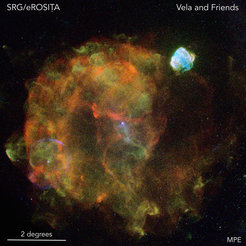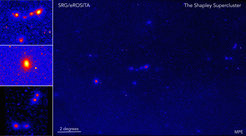Our deepest view of the X-ray sky
The eROSITA telescope has provided a new, sharp view of hot and energetic processes across the Universe.
Over the course of 182 days, the eROSITA X-ray telescope onboard SRG has completed its first full sweep of the sky. This new map of the hot, energetic universe contains more than one million objects, roughly doubling the number of known X-ray sources discovered over the 60-year history of X-ray astronomy. Most of the new sources are active galactic nuclei at cosmological distances, marking the growth of gigantic black holes over cosmic time. Clusters of galaxies in the new map will be used to track the growth of cosmic structures and constrain cosmological parameters. Closer to home, stars with hot coronae, binaries and supernova remnants dot our Galaxy, and we now have a complete map of the hot baryons in the Milky Way, something that can only be achieved with the 360-degree view provided by the eROSITA survey.

The energetic universe as seen with the eROSITA X-ray telescope.
The first eROSITA all-sky survey was conducted over a period of six months by letting the telescope rotate continuously, thus providing a uniform exposure of about 150-200 seconds over most of the sky, with the ecliptic poles being visited more deeply. As eROSITA scans the sky, the energy of the collected photons is measured with an accuracy ranging from 2% - 6%. To generate this image, in which the whole sky is projected onto an ellipse (so-called Aitoff projection) with the centre of the Milky Way in the middle and the body of the Galaxy running horizontally, photons have been colour-coded according to their energy (red for energies 0.3-0.6 keV, green for 0.6-1 keV, blue for 1-2.3 keV). The original image, with a resolution of about 10”, and a corresponding dynamic range of more than one billion, is then smoothed (with a 10’ FWHM Gaussian) in order to generate the above picture.
The red diffuse glow away from the galactic plane is the emission of the hot gas in the vicinity of the solar system (the Local Bubble). Along the plane itself, dust and gas absorb the lowest energy X-ray photons, so that only high-energy emitting sources can be seen, and their colour appears blue in the image. The hotter gas close to the galactic centre, shown in green and yellow, carries imprinted the history of the most energetic processes in the life of the Milky Way, such as supernova explosions, driving fountains of gas out of the plane, and, possibly, past outburst from the now dormant supermassive black hole in the centre of the galaxy. Piercing through this turbulent, hot diffuse medium, are hundreds of thousands of X-ray sources, which appear mostly white in the image, and uniformly distributed over the sky. Among them, distant active galactic nuclei (including a few emitting at a time when the Universe was less than one tenth of its current age) are visible as point sources, while clusters of galaxies reveal themselves as extended X-ray nebulosities. In total, about one million X-ray sources have been detected in the eROSITA all-sky image, a treasure trove that will keep the teams busy for the coming years.
A million X-ray sources revealing the nature of the hot universe – this is the impressive harvest of the first scan of the entire sky with the eROSITA telescope onboard SRG. “This all-sky image completely changes the way we look at the energetic universe,” says Peter Predehl, the Principal Investigator of eROSITA at the Max Planck Institute for Extraterrestrial Physics (MPE). “We see such a wealth of detail - the beauty of the images is really stunning.”
This first complete sky image from eROSITA is about 4 times deeper than the previous all-sky survey by the ROSAT telescope 30 years ago, and has yielded around 10 times more sources: about as many as have been discovered by all past X-ray telescopes combined. And while most classes of astronomical objects emit in X-rays, the hot and energetic Universe looks quite different to the one seen by optical or radio telescopes. Looking outside the body of our Galaxy, most of the eROSITA sources are active galactic nuclei, accreting supermassive black holes at cosmological distances, interspersed with clusters of galaxies, which appear as extended X-ray haloes shining thanks to the hot gas confined by their huge concentrations of dark matter. The all-sky image reveals in exquisite detail the structure of the hot gas in the Milky Way itself, and the circum-galactic medium, which surrounds it, whose properties are key to understanding the formation history of our Galaxy. The eROSITA X-ray map also reveals stars with strong, magnetically active hot coronae, X-ray binary stars containing neutron stars, black holes or white dwarves, and spectacular supernova remnants in our own and other nearby galaxies such as the Magellanic clouds.

Due to its size and close distance to Earth, the "Vela supernova remnant" which is shown in this picture is one of the most prominent objects in the X-ray sky. The Vela supernova exploded about 12000 years ago at a distance of 800 light-years and overlaps with at least two other supernova remnants, Vela Junior (in the picture seen as bluish ring at the bottom left) and Puppis-A (top right). Vela Junior was discovered just 20 years ago, although this object is so close to Earth that remains of this explosion were found in polar ice cores. All three supernova explosions produced both the X-ray-bright supernova remnants and neutron stars, which shine as intense X-ray point sources near the centres of the remnants. The quality of the new eROSITA data of this "stellar cemetery" will give astronomers many exciting new insights into the physical processes operating in the hot supernova plasma as well as for exploring the exotic neutron stars.
"We were all eagerly awaiting the first all-sky map from eROSITA,” says Mara Salvato, the scientist at MPE who leads the effort to combine eROSITA observations with other telescopes across the electromagnetic spectrum. “Large sky areas have already been covered at many other wavelengths, and now we have the X-ray data to match. We need these other surveys to identify the X-ray sources and understand their nature.” The survey is also a treasure trove of rare and exotic phenomena, including numerous types of transients and variables, such as flares from compact objects, merging neutron stars, and stars being swallowed by black holes. “eROSITA often sees unexpected bursts of X-rays from the sky,” continues Salvato. “We need to alert ground-based telescopes immediately to understand what’s producing them.”
Assembling the image has been a mammoth task. So far, the operations team has received and processed about 165 GB of data collected by eROSITA’s seven cameras. While relatively small by “big-data” standards on the ground, operating this complex instrument in space provided its own special challenges. “We check and monitor the health of the instrument on a daily basis, in cooperation with our colleagues in Moscow who operate the SRG spacecraft” explains Miriam Ramos-Ceja, a member of the eROSITA operations team at MPE. “This means we can respond quickly to any anomalies. We’ve been able to react to these immediately to keep the instrument safe, while collecting data at ~97% efficiency. It’s amazing to be able to communicate in real time with an instrument located 1.5 million kilometres away!” The data downlink occurs daily. “We perform immediate quality checks on the data”, she continues, “before it is being processed and analysed by the teams in Germany and Russia.”

The Shapley supercluster of galaxies is one of the most massive concentrations of galaxies in the local universe at a distance of about 650 million light-years (z~0.05). Each of the dozen extended structures is itself a cluster of galaxies, consisting of 100s to 1000s of individual galaxies, each denoting an intersection of filaments making up the large-scale structure in the Universe. This image spans 16 degrees across the sky (about 30 times the size of the full moon), which translates into about 180 million light-years across at the distance of the Shapley supercluster. The images on the left show a zoom of the the most massive clusters in the Shapley supercluster.
While the team is now busy analysing this first all-sky map and using the images and catalogues to deepen our understanding of cosmology and high-energy astrophysical processes, the telescope continues its sweep of the X-ray sky. “The SRG Observatory is now starting its second all-sky survey, which will be completed by the end of this year“, says Rashid Sunyaev, Lead Scientist of the Russian SRG team. “Overall, during the next 3.5 years, we plan to get 7 maps similar to the one seen in this beautiful image. Their combined sensitivity will be a factor of 5 better and will be used by astrophysicists and cosmologists for decades.“
Kirpal Nandra, head of the high-energy astrophysics group at MPE, adds “With a million sources in just six months, eROSITA has already revolutionized X-ray astronomy, but this is just a taste of what’s to come. This combination of sky area and depth is transformational. We are already sampling a cosmological volume of the hot Universe much larger than has been possible before. Over the next few years, we’ll be able to probe even further, out to where the first giant cosmic structures and supermassive black holes were forming.”
Further information:
On 11 June 2020, the eROSITA telescope completed its first survey of the entire X-ray sky. Launched on 13 July 2019 on-board the SRG spacecraft and now orbiting the second Lagrange point of the Earth-Sun-system, the telescope is in continuous scanning mode. During the first all-sky survey, each point in the sky was exposed to the eROSITA telescope for an average duration of 150-200 seconds. The regions close to the ecliptic poles, where the great circles traced by the telescope on the sky intersect, were revisited many times, accumulating exposures of up to a few hours. SRG will continue scanning the sky for three and half years more, with eROSITA performing seven more all-sky surveys in the process.
eROSITA is the primary instrument aboard SRG, a joint Russian-German science mission supported by the Russian Space Agency (Roskosmos), in the interests of the Russian Academy of Sciences represented by its Space Research Institute (IKI), and the Deutsches Zentrum für Luft- und Raumfahrt (DLR). The SRG spacecraft was built by Lavochkin Association (NPOL) and its subcontractors, and is operated by NPOL with support from the Max-Planck Institute for Extraterrestrial Physics (MPE).
The development and construction of the eROSITA X-ray instrument was led by the Max Planck Institute for Extraterrestrial Physics (MPE), with contributions from the Dr. Karl Remeis Observatory Bamberg, the University of Hamburg Observatory, the Leibniz Institute for Astrophysics Potsdam (AIP), and the Institute for Astronomy and Astrophysics of the University of Tübingen, with the support of DLR and the Max Planck Society. The Argelander Institute for Astronomy of the University of Bonn and the Ludwig-Maximilians-Universität Munich also participated in the science preparation for eROSITA.
The eROSITA data shown here were processed using the eSASS software system developed by the German eROSITA consortium.














